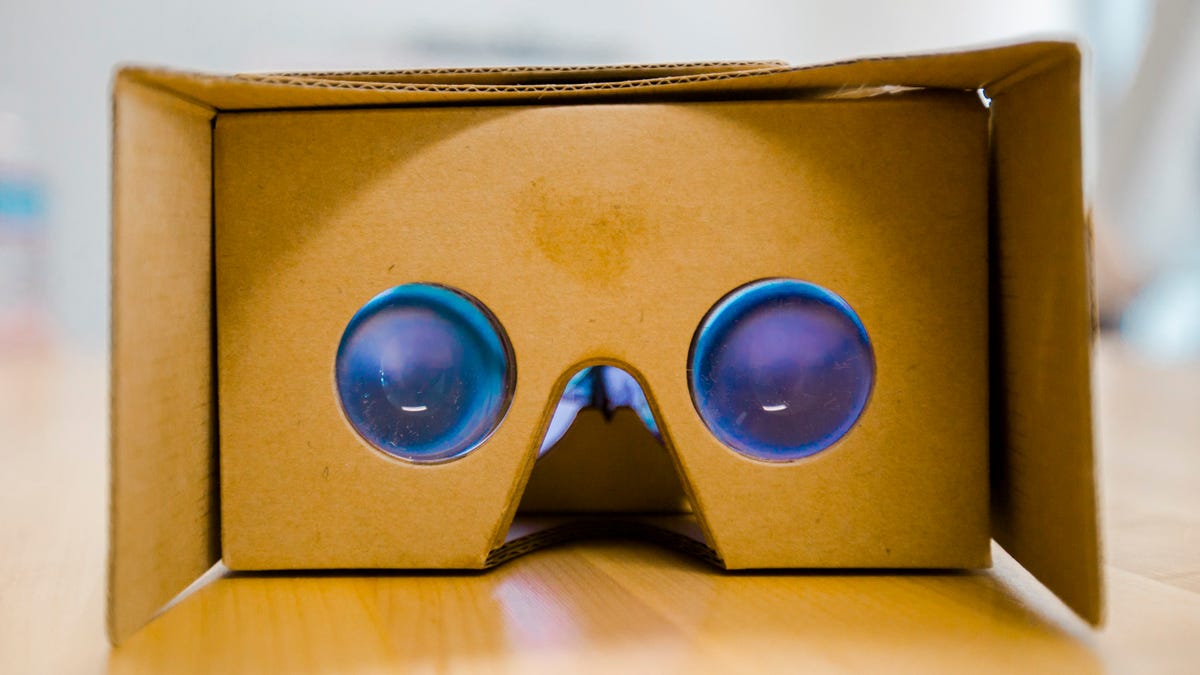Google may disconnect the phone for its VR vision of the future
The next version of the search giant's virtual reality goggles may be a lot more advanced than a folded piece of cardboard -- and not need a phone at all.

Of all the ways tech companies are gunning to drive virtual reality, Google may be working on something no one else has done yet: make the experience self-sufficient.
The search giant is developing a stand-alone headset, which would be the first VR goggle that isn't powered by a smartphone, laptop or gaming console, according to a report Thursday by The Wall Street Journal that cited unnamed sources.
The move would represent a novel approach as a scrum of tech companies, including Facebook, Samsung and HTC, jostle to bring the nascent technology to a mass audience. Facebook's $599 Oculus headset, available starting next month, requires a PC, while the offerings from HTC and Sony are also tied to a PC or game console. Samsung's Gear VR requires a Samsung Galaxy smartphone.
Google's device will reportedly have its own screen, outward-facing cameras and a high-powered processor based on chips from Movidius, a San Mateo, California-based startup that specializes in machine vision.
A Google spokeswoman declined to comment. Movidius acknowledged it has a "business relationship" with Google but wouldn't say anything else.
Once mostly the dream of video game makers, VR now has the tech industry taking a wider view of the experiences it can offer, from virtual trips to the Alps and walks through the world's most famous museums to visits to digital doctor's offices.
Google's attempt at something new shows how seriously it's taking virtual reality. Last month, the tech titan created its own VR division, putting vice president Clay Bavor at the helm. Bavor used to be in charge of Google apps as well, but the company cleared away all his other responsibilities to focus squarely on virtual reality.
It's a far cry from Google's first foray into VR two years ago with Cardboard, a no-frills, made-of-paper headset design that uses a smartphone as the screen. Cardboard, developed by Bavor and his team, isn't sold by Google -- it licenses the design to others who create the $20 to $25 headset. Google will also release an updated version of that product to be made of plastic, according to the Journal. The headset is also expected to include chips and sensors.
Glass, Tango and beyond
If the reports are true, it seems as though Google's approach could be similar to what it did with Google Glass, in the sense that this will be a fully formed piece of standalone hardware. Glass, experimental eyewear with a high-tech flourish, could connect with a phone but also worked on its own over Wi-Fi, avoiding a need to be tethered to any other device.
It's an unusual approach for VR at the moment, especially since it feels like both mobile and PC-based VR efforts are aiming for a level of industry consistency. Would a stand-alone unit run Android, Google's mobile software? Or would it be more of a head-mounted display that interfaces with phones, tablets and computers wirelessly?
There are reasons for Google to pursue this type of product. Cardboard needed to work with several types of smartphones, which meant screen sizes, resolutions and processors were inconsistent. Having all those things built into the headset itself would let VR content makers all step up to the same standard. That could help the whole experience look and feel a lot better.
Google's next VR device may ditch the requirement of a smartphone.
Facebook's Oculus is intended to work with higher-resolution screens with greater pixel density than most of the phones that Google Cardboard supports, allowing for crisper, sharper images and more impressive 3D graphics.
An optimized device might also reduce lag, allowing for a smoother, more immersive viewing experience. In contrast, Cardboard didn't have a head strap for a reason -- it's laggier, lower-powered feel means it's not intended to be used for extended sessions.
A new device would also help Google adopt position tracking, something missing from mobile VR right now. Current phone-based VR headsets let you turn your head, but they can't track movement across a room. Cameras on the outside of the headset, in the manner of what Google is reportedly building, could be depth-sensing ones like those used by Project Tango, another next-gen Google effort that tries to pack more sensors into phones and tablets. (Movidius also worked on Project Tango, which makes position tracking the likeliest reason for this specific hardware redesign.)
Cameras can help map out a room in 3D, help someone walk around in virtual reality without hitting a wall in real life (HTC's Vive headset uses an external camera like this), or help boost the reality of VR. It's a key step to developing next-level virtual reality applications, and the hardware to make that possible simply doesn't exist on everyday phones. A specially-built headset would be a logical move.
A stand-alone device does raise questions about what sort of processor it will require or how much battery life it will have.
But at least this one won't give you a paper cut.



